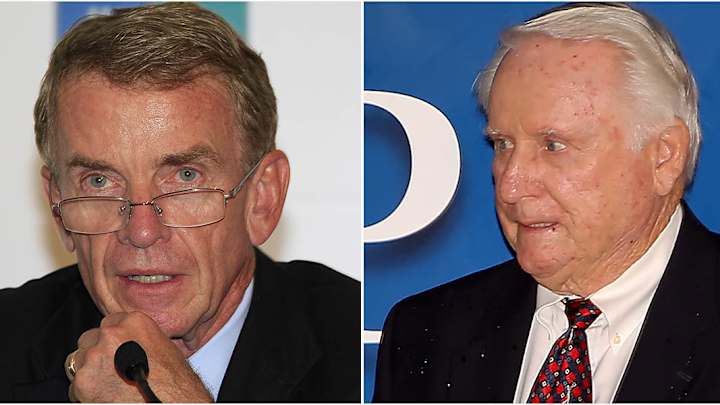PGA Tour’s greatest commissioner? It's a gimme

Deane Beman turned 82 last week, meaning we can add Father Time to the long list of foes the former PGA Tour commissioner has subdued over the years. Asked about his golf game, which was humming along at a rate of four or five rounds per week until recently, Beman concedes to a slowdown of sorts.
“Some practice, most days,” he said. “You have to work harder at my age to keep from falling behind faster.”

How many octogenarians beat balls in the Florida sun to get better? Before he became the godfather of professional golf, before he conceived dozens of ideas that would modernize the sport and transform the Tour into a TV-friendly, asset-bloated empire, Beman was a grinder. He won a British Amateur at age 21 and the U.S. Amateur in 1960 and 1963, beating guys bigger and longer by routinely knocking his 4-wood inside their 7-irons.
His pro career included four PGA Tour victories but lasted just seven seasons. A recurring hand injury ended Beman’s competitive days before he turned 40, although one can see now how fate had something much larger in mind. “The period of time when I was the commissioner [1974-94] was a very difficult one,” he said. “It wasn’t easy, nor was it popular, to abandon the status quo, to push through and make changes in a traditional game such as golf.
“I understood that. I saw things the way they could be, not the way they were.”
Now that Tim Finchem’s rubber-stamp induction to the World Golf Hall of Fame has been made official, this qualifies as the perfect time to laud the vast range of accomplishments by his predecessor. Beman could be brusque, pushy, even vindictive on occasion, but he was, without question, one of the most effective and influential commissioners in the history of sports.
When Beman succeeded Joe Dey 46 years ago, the Professional Bowlers Association had greater rights fees and significantly more TV airtime than the PGA Tour. Because of its logistics and the size of the playing field, a golf tournament cost a lot of money to produce. Ratings were low, and the three major networks were opposed to showing any form of commercialization – logos on hats, clothing, bags, etc. – during a telecast.
The young Tour boss spent five years gnawing at the system, looking for a way to defray production costs and get his players the type of exposure that not only would drive purses upward but make their personal endorsements more lucrative. From all that hand-wringing, the title sponsor was born. “We found a way to make our [corporate support] more valuable than the [financial] relationship with TV,” Beman said. “At that point, we were able to convince the networks this was the way it was going to be.”
To say Beman invented the concept of third-party underpinning would be a considerable overstatement. What he did devise was the triangular fiscal arrangement that exists to this day: the sponsor accounts for roughly half the advertising slots during the tournament which bears its name and helps subsidize the prize money allocated for that week. That same company has access to pro golf’s ultra-healthy demographics in numerous forms, and the networks don’t have to work so hard to sell commercials.
Everybody walks away happy. Pocketfuls of loot have a tendency to induce smiles. “It’s the thing I’m most proud of, bringing golf into the modern age of television sports,” Beman said. “Big-time sports, and we were able to do it without giving up what golf stands for.”
During his 20-year tenure, purses increased by about 700 percent, which Tiger Woods basically did by himself a generation later. Beman is also largely responsible for the Tour’s 501(c)6 tax-exempt status, a controversial categorization most recently challenged in 2017. That same year, Camp Ponte Vedra reported a net income of $56,288,569 off revenue of more than $1.47 billion.
Forbes magazine once referred to the Tour as a “not-for-profit money machine,” but Beman was adept at far more than counting beans. With immeasurable help from former CBS analyst Gary McCord, a fringe player in the early 1980s, he pioneered and approved the 125-man, “all exempt” circuit that continues to exist.
Beman was walking out of New York’s LaGuardia Airport one day in the 1970s and noticed a progressive information system leading passengers to taxis, rental cars and baggage claim. It wasn’t long before electronic scoreboards were popping up at every tournament. Beman brought us the Senior Tour and the Hogan Tour, and though both entities have undergone more name changes than an international spy, both would have to be considered successes by even the most change-resistant cynic.
The Players Championship? That was Beman’s baby, and to a certain extent, still is. “If the [tour pros] themselves had insisted that it’s a major and really embraced their own championship, they would be playing for an additional $50 million a year,” he told me in March 2019. I didn’t understand his funny math 13 months ago and have forgotten to ask for an explanation every time we’ve spoken since, but I’m not about to question the man on anything that mixes digits and dollar signs.
We could go into the PGA Tour’s ridiculously profitable pension plan or the Tournament Players Clubs that began sprouting up during Beman’s two decades in the corner office, but at some point, even success begins smelling like overkill. Beman was a true visionary, a man with a very complex plan, or as he put it during his retirement festivities more than 25 years ago, “the right guy at the right time.”
To conclude that he never received due credit for all his administrative brilliance literally goes without saying. They just don’t make halos that big.
Sign up to receive the Morning Read newsletter, along with Where To Golf Next and The Equipment Insider.
